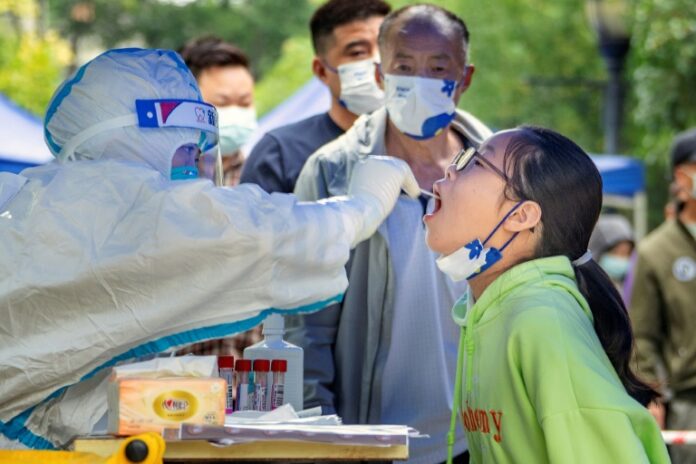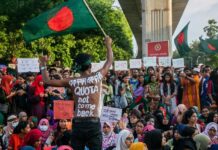Sudden chaotic exit from hardline pandemic controls leaves cities grappling with explosive COVID surge
Vincent Kolo, chinaworker.info
In response to a wave of anti-government protests in late November the Chinese dictatorship (CCP) has pivoted abruptly from its deeply unpopular Zero COVID regime. But for the Chinese masses this is a case of out of the frying pan into the fire. With no reliable data available and signs of deliberate underreporting of deaths, it seems major cities like Beijing, Shanghai and Guangzhou are experiencing an explosive surge of the Omicron variant, with other parts of the country awaiting the same grim fate in the weeks ahead.
According to official data new infections in the whole country are running at around 2,000 per day, a ludicrously low figure. Unofficial estimates say that half of Beijing’s 22m people have already been infected with Omicron. Even Hu Xijin, former editor of the Global Times, posted a rebuke on social media: “either report real figures or stop publishing them.”
China may now experience the fastest COVID wave in the history of the pandemic. Chinese experts predict 840 million people could be infected in the next few months. The terrifying speed and scale of this outbreak is due on one hand to the highly transmissible Omicron variants now spreading inside the country, plus a largely “immunologically naïve” population that has been spared exposure to the virus for three years due to a stringent Zero COVID policy based on lockdowns, travel restrictions and mass testing – all of which have suddenly been removed in many parts of the country.
Omicron is relatively mild for most people, but highly infectious. The BF.7 variant currently prevalent in China has a reproductive “R number” of 16, compared to 10 or 11 during last winter’s Omicron outbreak in the United States. This denotes the average number of people infected by each positive case. China’s top epidemiologist Zhong Nanshan told state media on 11 December that this number is even higher in China, with one person infecting 22 others. Whereas in the US last winter cases doubled every two to three days, “Now in China, the doubling time is like hours,” said epidemiologist Ben Cowling at the University of Hong Kong (NPR 15 December). Given the low vaccination rate among China’s elderly with only 40 percent of over 80s fully vaccinated there are projections of between half a million and 2 million COVID deaths in the coming waves.
Political crisis
In late November, protests erupted in around 20 cities and more than 80 universities against the never-ending lockdowns and testing strictures of the Zero COVID policy. These protests were historic, breaking the mold of protests over the past three decades in that they were national in scope and because they raised explicitly political demands for democratic rights and even for Xi Jinping to “step down”.
The CCP has invested huge sums in creating the world’s biggest and most technologically sophisticated police state. It did this precisely to make such an outbreak of protest impossible. Of course, this project was doomed to fail as we predicted. Despite the protests gathering relatively modest numbers, the mere fact they happened has plunged Xi’s regime into a state of crisis.
The timing and manner of the dictatorship’s abandonment of its Zero COVID controls defies all logic unless we understand it as a panic reaction to these protests and the fear of even more protests if it did nothing. Not only is it winter, with the Chinese New Year – the world’s biggest yearly human migration – barely a month away, but China was already experiencing its biggest surge in infections when the government u-turn came.
In none of the other countries that followed a Zero COVID strategy has it ended in such a haphazard, abrupt and poorly timed manner. In China, the key elements of an alternative pandemic strategy such as a vaccination booster campaign and beefing up the public healthcare system, especially ICU capacity, are only now being hastily improvised, instead of being prepared in advance.
Rather than a transition, it is as if the old pandemic control regime has fallen apart. The government has no ‘Plan B’ other than to improvise one day at a time. The state’s propaganda of the past three years, which closely identified the Zero COVID doctrine with Xi personally (he is the “commander-in-chief” of the “people’s war” against the virus), stressed this was the world’s best pandemic strategy and proof of China’s “superior system” compared to chaotic Western-style “democracies”. The disastrous pandemic policies of Western governments, rooted in decades of neoliberal welfare destruction, flattered Xi’s contrary but equally anti-working class approach.
Now, the Chinese regime’s pandemic strategy is being “optimized” according to its new buzzword. Zero COVID is not officially dead, but it is no longer mentioned in official statements. This is not the first time in history that a political campaign has continued in name long after it was terminated in practice – to avoid humiliating the leader. Mao’s Cultural Revolution did not officially end until his death in 1976, although in reality it ended already in 1969.
Why this? Why now?
Xi has now fallen silent, although he has clearly sanctioned this policy shift. Responsibility for dismantling Zero COVID has been devolved to local governments, in part to protect the emperor from the fallout. The dictatorship’s fear of widespread mass anger is evidently the main reason for this sudden 180-degree turn. But there is also an element of revenge: to punish the masses for daring to challenge Xi.
The dictatorship has understood that the virus can be an ally in pacifying the population and curbing new protests. It played a significant part in the CCP’s battle to reestablish control over Hong Kong in 2020, at a time when the mass anti-authoritarian struggle had already entered a downward phase. This was months before the national security law was imposed on the city. In many western countries the early phase of the pandemic, with cases surging and society thrown into chaos, was also accompanied by a cessation or sharp downturn of mass struggle.
Rather than fill the streets to enjoy their newfound mobility, the population of China’s biggest cities has largely avoided venturing out in fear of infection or because they are infected. Beijing last week was described by one netizen as a “virtual ghost town”. Ridership on the subway is lower now in Beijing and several other major cities than it was before the Zero COVID restrictions were lifted, when proof of a negative PCR test was required to use public transport.
The capital’s hospitals are reportedly overwhelmed, with scenes reminiscent of Hong Kong earlier this year, of patients forced to wait outside in hospital car parks. Alarming numbers of medical personnel are infected, with reports that doctors and nurses in Beijing are being ordered to work despite testing positive for COVID. Common fever medicines such as Paracetamol and Ibuprofen as well as self-testing kits have sold out in many cities, another sign the regime’s policy reversal was completely unplanned and knee-jerk. Blood banks are also reportedly running short.
Beijing’s crematoriums are working around the clock, increasing speculation the government is suppressing data about COVID deaths. In Wuhan, during the original outbreak in early 2020, it was widely believed the official death count was underreported. Officially, two people have died of COVID in Beijing since 3 December. A hashtag on the two deaths became the top trending item on social media, with many expressing disbelief.
Not only is China’s official death count out of whack with the experience of other countries after lifting restrictions, but it is challenged by eyewitness accounts. “Reuters journalists witnessed hearses lined up outside a designated COVID-19 crematorium in Beijing and workers in hazmat suits carrying the dead inside the facility,” reported Reuters on 19 December. Internet searches for “funeral homes” by Beijing residents are at their highest level since the pandemic began.
CCP’s internal power struggle
Xi’s regime has been under mounting pressure to exit from Zero COVID in order to address a deepening economic slump and staunch the accelerating trend of decoupling by Western companies. Many local governments have been brought to the edge of bankruptcy by the huge costs of maintaining the Zero COVID infrastructure, especially the demand for full-scale mass testing. Soochow Securities estimated that a year’s worth of mass testing could cost China’s local governments a combined 1.7 trillion yuan (US$257 billion), about 1.5 percent of GDP.
This economic pressure has exacerbated the power struggle inside the CCP and conflicts between the center and the regions. For Xi an important benefit of the Zero COVID policy was its role in the internal CCP power struggle as a tool to weed out critics and reward those displaying slavish loyalty.
Record youth unemployment (almost 20 percent officially), falling real wages and the implosion of the housing market are all important factors behind November’s protests. The dictatorship’s media and propaganda arms have of course not reported the protests. Officially, they did not happen. It would be extremely dangerous for this regime to acknowledge its hand was forced by mass pressure.
At the CCP’s 20th Congress only six weeks before this explosion of struggle, Xi Jinping again reiterated the need to maintain the Zero COVID policy. During the congress it was announced that China’s testing capacity had reached the level of an incredible 1 billion PCR tests per day. What this massive investment was actually for is a legitimate question today as mass testing is being summarily scrapped.
At the congress Xi purged the top-level Politburo Standing Committee of opposition elements and promoted acolytes like Li Qiang and Cai Qi, both strongly associated with enforcing Zero COVID in their cities. As Shanghai CCP boss, Li Qiang presided over the brutal two-month lockdown of China’s largest city earlier this year, stoking massive public discontent. It is no coincidence that during the November protests some of the most radical anti-government slogans surfaced in Shanghai, including chants of “Down with the CCP” and “Xi Jinping step down”.
Li’s counterpart in Beijing, Cai Qi, also promoted to the Standing Committee at the 20th Congress, announced in June that Zero COVID would be “maintained for the next five years”. This statement went viral, but not in the way Cai intended, and within hours the reference to “five years” had been deleted from news reports.
Zero COVID has now disappeared from official statements. Xi’s last public comments on the policy were at the 10 November Politburo meeting when he told them to stick “resolutely” with Zero COVID. It was not mentioned once in the new 10-point plan announced on 7 December by the National Health Commission (NHC) and the Joint Prevention and Control Mechanism of the State Council (China’s cabinet). This is a “stunning u-turn” as the Financial Times noted. But it’s also important to note that there has been no official announcement that the policy has ended. In typical CCP-ese, the policy has instead been “optimized”.
“Lying flat”
Xi’s regime has substituted one disastrous policy for another. It looks remarkably like the “lying flat” policy which CCP propaganda previously depicted as a failed Western strategy. This term has been used to villify those scientific experts who have dared to call for a different approach. Official statements portray the regime’s sudden chaotic change of course as a refinement based on alleged “successes”. State media now stresses the reduced severity of Omicron – which is hardly news – whereas previously it reported the opposite. It hails the 90 percent vaccination rate, but this was achieved more than a year ago, and excludes tens of millions of the most vulnerable.
All of the factors currently being cited to justify the sudden policy shift have been present for a long time, but Xi’s regime persisted with Zero COVID regardless. It did so partly for political reasons including the quest for an extreme form of social control and as a weapon in Xi’s power struggle agenda ahead of the 20th Congress (to cement his lifetime rule project).
What is happening now is a massive policy failure. Socialists have consistently criticized Xi’s Zero COVID policy for its lack of a scientific basis, its brutality and bureaucratic heavy-handedness. The lockdowns were not used to gain time to address China’s too-low vaccination rates. The IMF says 375 million people over the age of 15 in China have yet to receive three doses and this includes over 90 million over-60s. Rather than solve the crisis in the public healthcare system, resources have instead been misdirected into the gargantuan machinery of testing, quarantine and lockdown enforcement. The most effective – foreign – vaccines are banned in China (except for foreigners!), as part of Xi’s anti-Western nationalist propaganda.
According to official data as of 19 November only 1.9 million Chinese have been infected with COVID in a population of 1.4 billion. Feng Zijian, a former deputy director of the Center for Disease Control and Prevention, said he expected 60 percent of China’s population to be infected in an initial wave of infections – which translates into 840 million new cases. Eventually, as much as 90 percent of China’s population will have been infected, according to Feng.
The coming weeks look particularly uncertain. Even as many cities have abandoned the old policy, there are still lockdowns. Shanghai announced the closure of all its schools and kindergartens starting from 19 December. University students that chinaworker.info has spoken to in different cities report that many restrictions are still in place.
The CCP’s pandemic policy is likely to remain erratic, with zigzags and crises. Its new “lying flat” policy puts the biggest burden on the working class and on the precarious sector which includes 300 million migrant workers, on healthcare workers and on the rural population where public healthcare is in an even more dilapidated condition. There are 1.48 doctors and 2.1 nurses for every 1,000 people in rural areas, compared with 3.96 doctors and 5.4 nurses per 1,000 urban residents, according to the South China Morning Post (12 December 2022).
It cannot be excluded that the regime performs new 180-degree turns in the next period. Political zigzags are after all part of the CCP’s DNA. If the worst-case scenarios for COVID fatalities are realized we could see a new pivot back towards large scale lockdowns, although this will encounter increasing difficulties. Xi has so far maintained complete silence on the demise of Zero COVID, which could feasibly position him to reverse today’s policy while scapegoating other CCP leaders and local administrations with responsibility for its failure.
Other political somersaults are possible such as the implementation of a vaccine mandate for the elderly – a step the regime has avoided, fearing significant opposition arising from China’s appalling track record of defective vaccines long before COVID. It cannot be entirely excluded that the ban on foreign mRNA vaccines is lifted, depending on the severity of the situation.
Scope for concessions?
Xi’s regime has been forced to change course by mass pressure, but the new course is in many ways worse than its forerunner. It is not a real concession and far less a reform, in the sense of a tangible improvement. It does show to that significant minority of the population who know about the mass protests (most people don’t know) that struggle can force the dictatorship to retreat, at least partially. Marxists explain the importance of this as a crucial lesson for future struggles. But we also explain that more is needed.
ISA and chinaworker.info have explained that the capitalist dictatorship in China as a general rule possesses less political flexibility than a bourgeois democratic system with its parliament and rotating (capitalist) governments. Some challenges that don’t automatically endanger a Western-style “democratic” regime, such as the collapse of a government’s authority, could pose an existential crisis for a dictatorship.
For example in Britain the past year has seen a series of governments disintegrate in spectacular fashion, which reflects a historic crisis of the main capitalist party, the Tories. But this has not yet placed the collapse of Britain’s capitalist system on the agenda.
There are other examples where “democratic” capitalist governments maneuver with a degree of freedom that isn’t possible to the same extent in a rigidly authoritarian system as in China or at present in Iran. This is why the capitalist class as a general rule, except in specific conditions like those in China of historically belated, extremely unstable capitalist relations, prefers bourgeois democracy to bourgeois dictatorship. But even the most “democratic” capitalists can reconcile themselves to dictatorship if their system’s survival requires it.
Democratic demands, for example the demand for independent labour unions, or freedom of speech and the scrapping of draconian censorship measures, are resisted tooth and nail by the CCP regime because these things would endanger its rule, threatening to unleash a chain reaction of lost control heading towards dissolution and collapse. Therefore, any zigzag concessions will be followed by renewed repression.
The CCP is not a party, it is the state. The fall of the CCP therefore means the break-up of the state. This is the main reason Xi decided he had no alternative but to crush the democracy struggle in Hong Kong for fear it would eventually reach a point where it would spillover into mainland China.
This does not mean the dictatorship cannot make concessions when it is under pressure from a mass struggle. In 2010, Beijing forced the Japanese car companies to give 30 percent pay increases to the car workers in Guangdong, in order to end a wave of strikes that was also beginning to raise demands for an independent trade union. In 2003, in the face of what was then the biggest ever mass protest in Hong Kong, Beijing ordered the Hong Kong government to execute a humiliating retreat and scrap its planned ‘Article 23’ security law. The Hong Kong government fell – it was expendable. In Guangdong, the provincial CCP also staged a partial retreat over the protest village Wukan in 2011. CCP negotiators agreed to allow a village election and the release of arrested protesters.
What did these concessions have in common? Firstly, and most importantly, they did not fundamentally threaten the dictatorship’s power and control. Secondly, the conceding party in these examples was not the central government but a subordinate agency or outside party – a future scapegoat. Thirdly, all these concessions could be and were in fact rolled back through new counterrevolutionary attacks.
Therefore, the CCP’s rule historically is not entirely without political flexibility. But it is far more limited than in most “democratic” capitalist regimes. And this flexibility has decreased dramatically under Xi Jinping’s rule. The “stick” of repression has got bigger while the “carrot” of concessions has got smaller. Under pressure from a potentially revolutionary movement or crisis, the CCP regime could make promises and offer reforms, which can never be trusted. What they won’t do is dissolve the dictatorship and capitalism. This task requires a mass workers’ movement with a revolutionary democratic and socialist program.




